Research
The Standard Model of particle physics
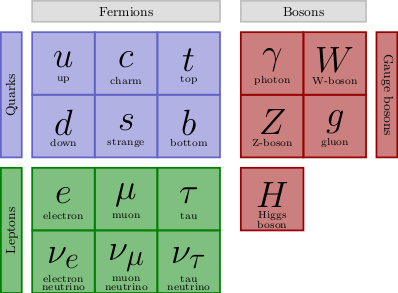 The objective of the Emmy-Noether group is the search for phenomena beyond the Standard Model.
The Standard Model is extremely successfull in the description of the fundamental building blocks of matter and their interactions.
Nevertheless it is incomplete, since it does not explain the matter-antimatter asymmetry in the universe and does not contain a candidate for dark matter.
Extensions of the Standard Model that answer these open questions typically introduce new heavy particles.
The objective of the Emmy-Noether group is the search for phenomena beyond the Standard Model.
The Standard Model is extremely successfull in the description of the fundamental building blocks of matter and their interactions.
Nevertheless it is incomplete, since it does not explain the matter-antimatter asymmetry in the universe and does not contain a candidate for dark matter.
Extensions of the Standard Model that answer these open questions typically introduce new heavy particles.
Searches for New Physics with rare B decays
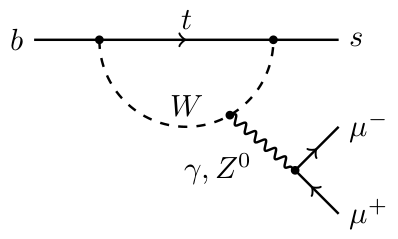 The Emmy-Noether group searches for these new particles beyond the Standard Model using rare decays of particles containing b quarks.
Decays of b quarks into lighter quarks of the same charge are heavily suppressed in the Standard Model and only allowed via quantum loop processes (GIM mechanism).
New particles can contribute significantly and affect both the decay rates of these particles as well as the angular distributions of the final state particles.
These new particles can have masses far beyond the centre-of-mass energies of todays particle colliders and might therefore be inaccessible using direct searches.
The Emmy-Noether group searches for these new particles beyond the Standard Model using rare decays of particles containing b quarks.
Decays of b quarks into lighter quarks of the same charge are heavily suppressed in the Standard Model and only allowed via quantum loop processes (GIM mechanism).
New particles can contribute significantly and affect both the decay rates of these particles as well as the angular distributions of the final state particles.
These new particles can have masses far beyond the centre-of-mass energies of todays particle colliders and might therefore be inaccessible using direct searches.
The LHCb experiment at the LHC
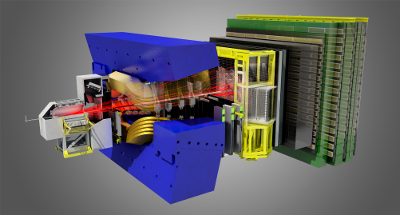 The LHCb experiment at the Large Hadron Collider (LHC) at CERN is a dedicated experiment for the analysis of particles containing b quarks.
The LHC produces an enormous amount of b quarks, around 1012 b anti-b quark pairs per year at a centre-of-mass energy of 13 TeV.
Together with the highly efficient reconstruction and selection of b decays this allows for the study of even very rare decays.
In particular the decays of interest for the Emmy-Noether group, that have typical branching fractions of 10-6 (ie they only occur in one case of a million) can be precisely studied.
The LHCb experiment at the Large Hadron Collider (LHC) at CERN is a dedicated experiment for the analysis of particles containing b quarks.
The LHC produces an enormous amount of b quarks, around 1012 b anti-b quark pairs per year at a centre-of-mass energy of 13 TeV.
Together with the highly efficient reconstruction and selection of b decays this allows for the study of even very rare decays.
In particular the decays of interest for the Emmy-Noether group, that have typical branching fractions of 10-6 (ie they only occur in one case of a million) can be precisely studied.
State of the field
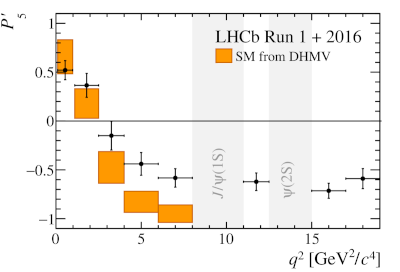 The main focus of the Emmy-Noether group are semileptonic decays where the b quark decays into an s quark and two leptons (muons or electrons).
Several analyses of rare decays in this area currently show interesting tensions with Standard Model predictions with a significance of around three standard deviations [1] [2] [3] [4].
These tensions are also known as the so-called flavour anomalies.
While consistent New Physics explanations for the tensions exist,
unexpectedly large Standard Model contributions can not yet be excluded.
To clarify the situation, more precise measurements are needed and updated measurements using the LHCb Run 2 data are eagerly awaited.
Of particular importance in this context are observables that can be precisely predicted in the Standard Model.
Examples are tests of lepton universality and searches for lepton number violating decays.
The main focus of the Emmy-Noether group are semileptonic decays where the b quark decays into an s quark and two leptons (muons or electrons).
Several analyses of rare decays in this area currently show interesting tensions with Standard Model predictions with a significance of around three standard deviations [1] [2] [3] [4].
These tensions are also known as the so-called flavour anomalies.
While consistent New Physics explanations for the tensions exist,
unexpectedly large Standard Model contributions can not yet be excluded.
To clarify the situation, more precise measurements are needed and updated measurements using the LHCb Run 2 data are eagerly awaited.
Of particular importance in this context are observables that can be precisely predicted in the Standard Model.
Examples are tests of lepton universality and searches for lepton number violating decays.
Further Reading
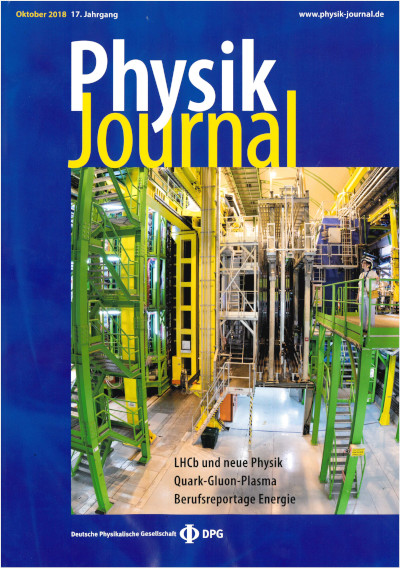 The flavour anomalies are also topic of a review article in the Physik Journal of the German Physical Society (October 2018) available here: C. Langenbruch et al., Physik Journal 17 (2018) Nr. 10 (in German). A more detailed review article has been published in Progress in Particle and Nuclear Physics 120 (2021) 103885 (arXiv:2107.04822).
The flavour anomalies are also topic of a review article in the Physik Journal of the German Physical Society (October 2018) available here: C. Langenbruch et al., Physik Journal 17 (2018) Nr. 10 (in German). A more detailed review article has been published in Progress in Particle and Nuclear Physics 120 (2021) 103885 (arXiv:2107.04822).